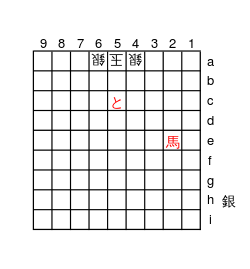Tsumeshogi

Tsumeshogi (詰将棋 or 詰め将棋 tsumeshōgi) or tsume is the Japanese term for a shogi problem in which the goal is to checkmate the opponent's King. Tsume problems present a situation that might occur in a shogi game, and the solver must find out how to achieve checkmate. It is similar to a chess problem.
Rules
Tsume problems have set rules for how they must be constructed and completed. If the solver breaks any of the rules, he has not solved the problem correctly. If the composer breaks any rules, he has not constructed a tsumeshogi.
- The attacking side is Black (先手 sente); meaning, he plays first.
- The attacking side's King is usually not present on the board.
- All of the attacking side's moves must be checks.
- When checkmate is reached, the attacking side must not have any pieces in hand.
- White (the defender, or the side with the king) must move in such a way to delay checkmate as long as possible.
- White has in hand all pieces not in the board or in the attacking side's hand, not counting the other King.
- White can drop any piece in hand to delay or prevent checkmate.
- White may not resort to futile interpositions, i.e., dropping pieces just to slow down the mating attack without essentially changing any of the moves in the solution.
Purposes of tsume problems
Tsume problems can be used to fulfill one of two tasks: to train in shogi strategy or to be created as a work of art.
Shogi training
Tsume problems are considered very good training for playing shogi. They teach not only how to effectively checkmate the king but also to predict moves and plan out a long series of moves before achieving a goal. There are many websites and books dedicated to tsume problems for this purpose.
As a work of art
Many shogi players for centuries have created tsume problems with long and deliberate mating lines as artwork. They might consist of the pieces making geometric shapes, a theme which is used throughout the problem, the removal of all pieces on the board (called a Smoke Mate), or a set number of moves. One of the most famous tsume artists is Kanju Itou, who wrote in 1755 Shogi Zukou (将棋図巧), a famous collection of artistic tsume problems.[1] The main tsume shogi prize in shogi world is "Kanju Prize".[2]
Notes
References
- ↑ Kanju Itou-ni tsuite (in Japanese).
- ↑ History of the Kanju Prize(in Japanese).
Bibliography
- Tsume Puzzles for Japanese Chess: Introduction to Shogi Mating Riddles (2011) by T. Gene Davis